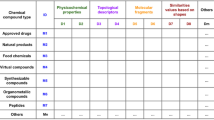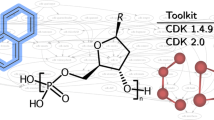Abstract
Chemoinformatics is the application of informatics methods to solve chemical problems. Although this term was introduced only a few years ago, this field has a long history with its roots going back more than 40 years. Work on chemical structure representation and searching, quantitative structure–activity relationships, chemometrics, molecular modeling as well as computer-assisted structure elucidation and synthesis design was initiated in the 1960s. These different origins have now merged into a discipline of its own that is in full bloom. All areas of chemistry from analytical chemistry to drug design can benefit from chemoinformatics methods. And there are still many challenging chemical problems waiting for solutions through the further development of chemoinformatics.



Similar content being viewed by others
References
FK Brown (1998) Annu Rev Med Chem 33:375–384
Paris G (August 1999 Meeting of the American Chemical Society), quoted by W. Warr at http://www.warr.com/warrzone.htm
FH Allen (2002) Acta Crystallogr B58:380–388 http://www.ccdc.cam.ac.uk/
FA Tate (1967) Annu Rev Inf Sci Technol 2:285–309
EG Smith (1968) The Wiswesser line-formula chemical notation. McGraw-Hill
GM Dyson, MF Lynch, HL Morgan (1968) Inf Storage Retr 4:27–83
D Weininger (1988) J Chem Inf Comput Sci 28:31–36
HL Morgan (1965) J Chem Doc 5:107–113
LC Ray, RA Kirsch (1957) Science 126:814–819
EH Sussenguth (1965) J Chem Doc 5:36–43
GW Adamson, J Cowell, MF Lynch, AHW McLure, WG Town, AM Yapp (1973) J Chem Doc 13:153–157
C Hansch, T Fujita (1964) J Am Chem Soc 86:856?864 ibid. 1616–1626
SM Free Jr, JW Wilson (1964) J Med Chem 7:395–399
QSAR and Modelling Society: http://www.qsar.org Molecular Graphics and Modeling Society: http://mgms.org
BR Kowalski, CF Bender (1972) J Am Chem Soc 94:5632–5639
S Wold, A Ruhe, H Wold, WJ Dunn III (1984) SIAM J Sci Statist Comput 5:735–743
International Chemometrics Society: http://www.mamics.nysaes.cornell.edu/chem-society.html
J Zupan, J Gasteiger (1999) Neural networks in chemistry and drug design, 2nd edn. Wiley-VCH, Weinheim
AM Lesk (1977) Comput Biol Med 7:113–129
RK Lindsay, BG Buchanan, EA Feigenbaum, J Lederberg (1980) Applications of artificial intelligence for organic chemistry; the DENDRAL project. McGraw-Hill, New York
NAB Gray (1986) Computer assisted structure elucidation. Wiley, New York
SI Sasaki, Abe, T Ouki, M Sakamoto, S Ochiai (1968) Anal Chem 40:2220–2223
CA Shelley, TR Hays, ME Munk, HV Roman (1978) Anal Chim Acta 103:121–132
EJ Corey, WT Wipke (1969) Science 166:178–193
J Blair, J Gasteiger, C Gillespie, PD Gillespie, I Ugi (1974) Tetrahedron 30:1845–1859
JB Hendrickson (1971) J Am Chem Soc 93:6847–6854
HL Gelernter, NS Sridharan, AJ Hart, S-C Yen (1973) Top Curr Chem 41:113–150
J Gasteiger (ed) (2003) Handbook of chemoinformatics—from data to knowledge. Wiley-VCH, Weinheim
J Gasteiger, T Engel (Eds) (2003) Chemoinformatics—a textbook. Wiley-VCH, Weinheim
AR Leach, VJ Gillet (2003) An introduction to chemoinformatics, Kluwer Adademic, Dordrecht
P Selzer, J Gasteiger, H Thomas, R Salzer (2000) Chem Eur J 6:920–927
J Aires de Sousa, M Hemmer, J Gasteiger (2002) Anal Chem 74:80–90
W Robien (1998) In: PvR Schleyer, NL Allinger, T Clark, J Gasteiger, PA Kollman, HF Schaefer III, RR Schreiner (eds) Encyclopedia of computational chemistry, vol 3. Wiley, Chichester, pp 1845–1857
C Steinbeck (2001) J Chem Inf Comput Sci 41:1500–1507
M Pförtner, M Sitzmann (2003) In: J Gasteiger (ed) Handbook of chemoinformatics, Wiley-VCH, Weinheim, pp 1457–1507
Acknowledgements
The development of the new discipline of chemoinformatics was only possible because quite a few scientists in different areas of chemistry were visionaries who realized the great potential of computer technology as well as mathematics and informatics methods for solving chemical problems. They ventured into unexplored areas and came up with novel solutions. In my research group I was lucky enough to have a series of able coworkers take up the challenge and explore into an area where the outcome was not clear. In this way, we could achieve a lot. I am indebted to my coworkers for pushing ahead with our research and to my colleagues who worked hard to develop chemoinformatics into a discipline of its own.
Author information
Authors and Affiliations
Corresponding author
Rights and permissions
About this article
Cite this article
Gasteiger, J. Chemoinformatics: a new field with a long tradition. Anal Bioanal Chem 384, 57–64 (2006). https://doi.org/10.1007/s00216-005-0065-y
Received:
Accepted:
Published:
Issue Date:
DOI: https://doi.org/10.1007/s00216-005-0065-y




